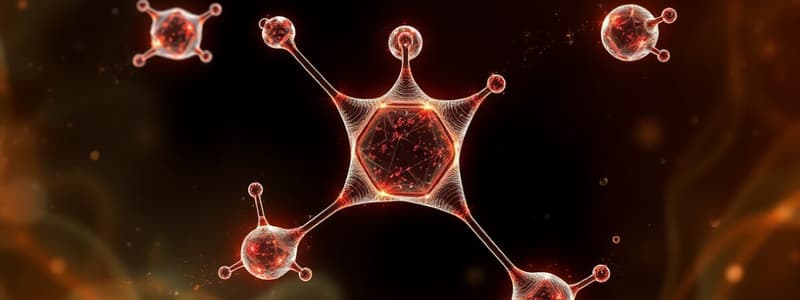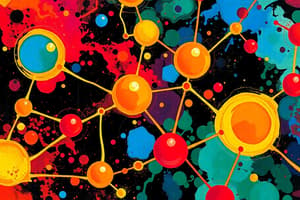Podcast
Questions and Answers
What is the primary reason for the bent shape of the water molecule (H₂O)?
What is the primary reason for the bent shape of the water molecule (H₂O)?
- The equal distribution of bonding electrons around the oxygen atom.
- The repulsion between the lone pairs of electrons on the oxygen atom. (correct)
- The lack of hybridization of oxygen's 2s and 2p orbitals.
- The presence of exactly two sigma bonds between oxygen and hydrogen atoms.
In the formation of water (H₂O), oxygen's 1s² electrons directly participate in the hybridization process.
In the formation of water (H₂O), oxygen's 1s² electrons directly participate in the hybridization process.
False (B)
Describe the type of hybridization that occurs in the oxygen atom of a water molecule (H₂O) and explain how it affects the molecule's shape.
Describe the type of hybridization that occurs in the oxygen atom of a water molecule (H₂O) and explain how it affects the molecule's shape.
sp³ hybridization causes a bent molecular shape due to repulsion from two lone pairs.
In water (H₂O), the oxygen atom undergoes ______ hybridization, resulting in four hybrid orbitals.
In water (H₂O), the oxygen atom undergoes ______ hybridization, resulting in four hybrid orbitals.
Match the following descriptions to the correct components regarding the formation of a water molecule:
Match the following descriptions to the correct components regarding the formation of a water molecule:
Considering the electron configuration of oxygen in a water molecule, which orbitals are involved in the sp³ hybridization process?
Considering the electron configuration of oxygen in a water molecule, which orbitals are involved in the sp³ hybridization process?
The bond angle in a water molecule is exactly 109.5° due to perfect tetrahedral geometry.
The bond angle in a water molecule is exactly 109.5° due to perfect tetrahedral geometry.
Explain how the electron configuration of the oxygen atom changes during the formation of a water molecule, focusing on the role of its valence electrons.
Explain how the electron configuration of the oxygen atom changes during the formation of a water molecule, focusing on the role of its valence electrons.
Which of the following statements accurately describes the relationship between sigma ($\sigma$) and pi ($\pi$) bonds?
Which of the following statements accurately describes the relationship between sigma ($\sigma$) and pi ($\pi$) bonds?
In a molecule with sp² hybridization, you would expect to find two pi ($\pi$) bonds and two sigma ($\sigma$) bonds.
In a molecule with sp² hybridization, you would expect to find two pi ($\pi$) bonds and two sigma ($\sigma$) bonds.
What type of hybridization is present in a molecule with a linear geometry and a bond angle of 180°?
What type of hybridization is present in a molecule with a linear geometry and a bond angle of 180°?
A triple bond consists of one sigma ($\sigma$) bond and ______ pi ($\pi$) bonds.
A triple bond consists of one sigma ($\sigma$) bond and ______ pi ($\pi$) bonds.
Match the following hybridizations with their corresponding geometries:
Match the following hybridizations with their corresponding geometries:
Which molecule is an example of sp³ hybridization?
Which molecule is an example of sp³ hybridization?
Sp hybridization results in three hybrid orbitals and one unhybridized p orbital.
Sp hybridization results in three hybrid orbitals and one unhybridized p orbital.
In ethene (C₂H₄ ), how many sigma and pi bonds are present between the two carbon atoms?
In ethene (C₂H₄ ), how many sigma and pi bonds are present between the two carbon atoms?
An atom with four sigma bonds and no pi bonds or lone pairs is hybridized as ______.
An atom with four sigma bonds and no pi bonds or lone pairs is hybridized as ______.
What characteristic is associated with sigma ($\sigma$) bonds?
What characteristic is associated with sigma ($\sigma$) bonds?
What is the primary reason why the bond angle in water (H₂O) is approximately 104.5° instead of the ideal tetrahedral angle of 109.5°?
What is the primary reason why the bond angle in water (H₂O) is approximately 104.5° instead of the ideal tetrahedral angle of 109.5°?
In sp² hybridization, one s orbital and two p orbitals combine to form three sp² hybrid orbitals, resulting in a tetrahedral geometry.
In sp² hybridization, one s orbital and two p orbitals combine to form three sp² hybrid orbitals, resulting in a tetrahedral geometry.
How many unhybridized p orbitals remain when a carbon atom undergoes sp hybridization?
How many unhybridized p orbitals remain when a carbon atom undergoes sp hybridization?
In ethene (C₂H₄), each carbon atom undergoes sp² hybridization, forming a ______ bond between the two carbon atoms.
In ethene (C₂H₄), each carbon atom undergoes sp² hybridization, forming a ______ bond between the two carbon atoms.
Match each type of hybridization with its corresponding molecular geometry:
Match each type of hybridization with its corresponding molecular geometry:
Which type of hybridization is associated with molecules containing triple bonds?
Which type of hybridization is associated with molecules containing triple bonds?
Hybridization fundamentally changes the electron configuration of an atom by altering the number of core electrons.
Hybridization fundamentally changes the electron configuration of an atom by altering the number of core electrons.
What is the bond angle in a molecule with linear geometry resulting from sp hybridization?
What is the bond angle in a molecule with linear geometry resulting from sp hybridization?
Oxygen has ______ unpaired electrons, each occupying a different 2p orbital.
Oxygen has ______ unpaired electrons, each occupying a different 2p orbital.
In H₂O, how many of the sp³ hybrid orbitals on oxygen are used to form sigma (σ) bonds with hydrogen atoms?
In H₂O, how many of the sp³ hybrid orbitals on oxygen are used to form sigma (σ) bonds with hydrogen atoms?
The concept of hybridization is used because unhybridized atomic orbitals always accurately predict molecular shapes and bonding.
The concept of hybridization is used because unhybridized atomic orbitals always accurately predict molecular shapes and bonding.
What is the spatial arrangement of the three sp² hybrid orbitals?
What is the spatial arrangement of the three sp² hybrid orbitals?
Which of the following describes the 'effective' configuration of oxygen after sp³ hybridization in H₂O?
Which of the following describes the 'effective' configuration of oxygen after sp³ hybridization in H₂O?
In sp hybridization, two ______ orbitals remain unhybridized and can participate in forming pi bonds.
In sp hybridization, two ______ orbitals remain unhybridized and can participate in forming pi bonds.
How many sigma (σ) bonds does each carbon atom form with hydrogen atoms in ethene (C₂H₄)?
How many sigma (σ) bonds does each carbon atom form with hydrogen atoms in ethene (C₂H₄)?
Flashcards
What is Hybridization?
What is Hybridization?
The mixing of atomic orbitals to form new hybrid orbitals suitable for chemical bonding.
What are sp³ hybrid orbitals?
What are sp³ hybrid orbitals?
Hybrid orbitals formed by mixing one 2s and three 2p orbitals.
What is Oxygen (O)?
What is Oxygen (O)?
Atomic number 8; its electron configuration is 1s² 2s² 2p⁴.
What are valence orbitals?
What are valence orbitals?
Signup and view all the flashcards
What is sp³ hybridization in water?
What is sp³ hybridization in water?
Signup and view all the flashcards
What are the functions of the four sp³ orbitals in H₂O?
What are the functions of the four sp³ orbitals in H₂O?
Signup and view all the flashcards
Why does H₂O have a bent shape?
Why does H₂O have a bent shape?
Signup and view all the flashcards
How does H₂O form sigma bonds?
How does H₂O form sigma bonds?
Signup and view all the flashcards
sp³ Hybridization
sp³ Hybridization
Signup and view all the flashcards
sp³ Geometry
sp³ Geometry
Signup and view all the flashcards
sp² Hybridization
sp² Hybridization
Signup and view all the flashcards
sp² Geometry
sp² Geometry
Signup and view all the flashcards
sp Hybridization
sp Hybridization
Signup and view all the flashcards
sp Geometry
sp Geometry
Signup and view all the flashcards
Sigma (σ) Bond
Sigma (σ) Bond
Signup and view all the flashcards
Pi (π) Bond
Pi (π) Bond
Signup and view all the flashcards
sp³ Hybridization Rule
sp³ Hybridization Rule
Signup and view all the flashcards
sp² Hybridization Rule
sp² Hybridization Rule
Signup and view all the flashcards
Valence Orbitals
Valence Orbitals
Signup and view all the flashcards
Hybridization
Hybridization
Signup and view all the flashcards
sp³ Orbitals in Water (H₂O)
sp³ Orbitals in Water (H₂O)
Signup and view all the flashcards
Bond Angle of Water (H₂O)
Bond Angle of Water (H₂O)
Signup and view all the flashcards
Shape of Water (H₂O)
Shape of Water (H₂O)
Signup and view all the flashcards
Oxygen's Configuration After sp³ Hybridization in H₂O
Oxygen's Configuration After sp³ Hybridization in H₂O
Signup and view all the flashcards
Geometry of sp² Orbitals
Geometry of sp² Orbitals
Signup and view all the flashcards
Unhybridized p Orbital in sp²
Unhybridized p Orbital in sp²
Signup and view all the flashcards
sp² Hybridization in Ethene (C₂H₄)
sp² Hybridization in Ethene (C₂H₄)
Signup and view all the flashcards
Two sigma (σ) bonds with two hydrogen atoms with sp² in Ethene (C₂H₄)
Two sigma (σ) bonds with two hydrogen atoms with sp² in Ethene (C₂H₄)
Signup and view all the flashcards
Geometry of sp Orbitals
Geometry of sp Orbitals
Signup and view all the flashcards
Unhybridized p Orbitals in sp
Unhybridized p Orbitals in sp
Signup and view all the flashcards
Study Notes
- In hybridization, 2s and 2p orbitals combine to form sp, sp², or sp³ hybrid orbitals depending on the bonding environment.
sp³ Hybridization and H₂O
- Oxygen (O) has an atomic number of 8, with an electron configuration of 1s² 2s² 2p⁴.
- Valence orbitals (2s² and 2p⁴) participate in bonding.
- Oxygen atom in H₂O undergoes sp³ hybridization, where the 2s orbital and three 2p orbitals mix to form four sp³ hybrid orbitals.
- Two sp³ orbitals contain lone pairs, and two form sigma bonds with hydrogen atoms.
- H₂O has a bent shape with a bond angle of about 104.5° due to repulsion between lone pairs.
- Oxygen starts with 1s² 2s² 2p⁴, then hybridizes to four sp³ orbitals for bonding.
- Two sp³ orbitals bond with hydrogen atoms.
- Two sp³ orbitals remain as lone pairs.
Electron Configuration Post-Hybridization
- For oxygen in H₂O the original electron configuration before bonding is 1s² 2s² 2p⁴.
- Post-hybridization, the 2s and 2p orbitals combine to form four sp³ hybrid orbitals.
- Two sp³ hybrid orbitals contain lone pairs.
- Two sp³ hybrid orbitals form O-H sigma bonds by overlapping with hydrogen 1s electrons.
- Effective configuration after hybridization is: 1s² (sp³)⁴.
sp² Hybridization
- One 2s orbital and two 2p orbitals combine to form three sp² hybrid orbitals.
- Shape of the three sp² hybrid orbitals is trigonal planar geometry, 120° apart.
- One 2p orbital remains unhybridized and can form pi (π) bonds (usually in double bonds).
- Each carbon in ethene undergoes sp² hybridization.
- Three sp² hybrid orbitals on each carbon:
- Two sigma (σ) bonds with two hydrogen atoms
- One sigma (σ) bond between the two carbon atoms
- One unhybridized 2p orbital on each carbon creates a pi (π) bond between the two carbons, forming a C=C double bond.
sp Hybridization
- One 2s orbital and one 2p orbital combine to form two sp hybrid orbitals.
- Two sp hybrid orbitals arrange in are arranged in a linear geometry at 180°.
- Two 2p orbitals remain unhybridized and create two pi (π) bonds (usually in triple bonds).
- Each carbon atom in ethyne undergoes sp hybridization.
- Two sp hybrid orbitals on each carbon:
- One sigma (σ) bond with hydrogen
- One sigma (σ) bond between the two carbon atoms
- Two unhybridized 2p orbitals on each carbon form two pi (π) bonds, creating the C≡C triple bond.
Hybridization Summary
- sp³ Hybridization
- Orbitals is one s + three p = four sp³ hybrid orbitals.
- Geometry: tetrahedral, 109.5° bond angles.
- Example: methane (CH₄), H₂O.
- No unhybridized p orbitals.
- sp² Hybridization
- Orbitals is one s + two p = three sp² hybrid orbitals.
- Geometry: trigonal planar, 120° bond angles.
- Example: ethene (C₂H₄).
- One unhybridized p orbital, forms π bonds.
- sp Hybridization
- Orbitals is one s + one p = two sp hybrid orbitals.
- Geometry: linear, 180° bond angles.
- Example: ethyne (C₂H₂).
- Two unhybridized p orbitals, forms π bonds.
Hybridization, Geometry, and Bonding Summary
- sp³: 4 hybrid orbitals, tetrahedral geometry, 109.5° bond angles.
- Example: methane (CH₄), H₂O.
- Four sigma bonds (CH₄); two sigma bonds + two lone pairs (H₂O).
- No unhybridized p orbitals; only sigma bonds.
- sp²: 3 hybrid orbitals, trigonal planar geometry, 120° bond angles.
- Example: ethene (C₂H₄).
- Three sigma bonds; one pi bond in double bonds.
- One unhybridized p orbital; forms one pi bond and three sigma bonds.
- sp: 2 hybrid orbitals, linear geometry, 180° bond angles.Ethyne (C₂H₂).
- Example: ethyne (C₂H₂).
- Two sigma bonds; two pi bonds in triple bonds.
- Two unhybridized p orbitals; forms two pi bonds and two sigma bonds.
Sigma (σ) and Pi (π) Bonds
- Sigma (σ) Bonds is the strongest covalent bond.
- Formed by direct overlap of orbitals between atoms.
- Can form from overlap of hybrid orbitals (sp, sp², sp³) or hybrid and non-hybridized orbitals (s).
- All single bonds consist of one sigma bond.
- Pi (π) Bonds form when two unhybridized p orbitals overlap side-by-side.
- Forms only after a sigma bond.
- Occur in double or triple bonds.
- Double bond is one sigma bond and one pi bond.
- Triple bond is one sigma bond and two pi bonds.
- Sigma bonds allow free rotation, pi bonds restrict rotation.
Determining Hybridization and Bond Type
- sp³ - Atom with four sigma bonds or lone pairs with no pi bonds is sp³ hybridized.
- Examples: methane (CH₄), water (H₂O).
- Tetrahedral geometry, no pi bonds (only sigma bonds).
- sp² - Atom with three sigma bonds and one pi bond is sp² hybridized.
- Example: ethene (C₂H₄).
- Trigonal planar geometry; pi bonds occur in double bonds.
- Double bonds consist of one sigma bond and one pi bond.
- sp - Atom with two sigma bonds and two pi bonds is sp hybridized.
- Example: ethyne (C₂H₂).
- Linear geometry; pi bonds occur in triple bonds.
- Triple bonds consist of one sigma bond and two pi bonds.
Studying That Suits You
Use AI to generate personalized quizzes and flashcards to suit your learning preferences.



